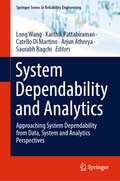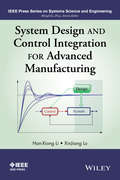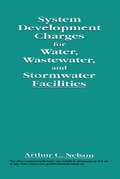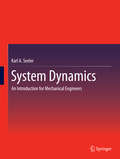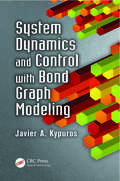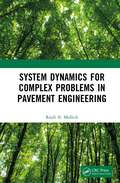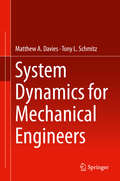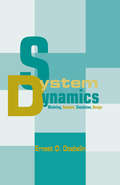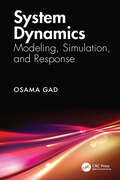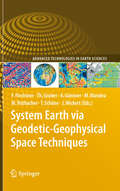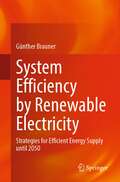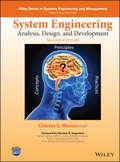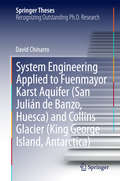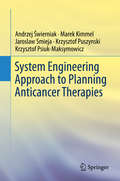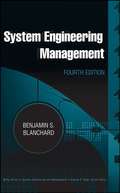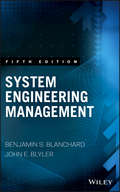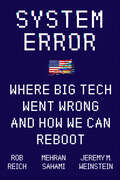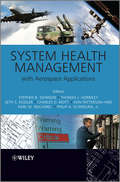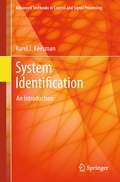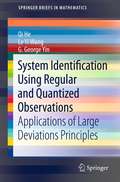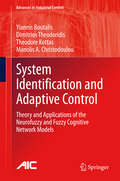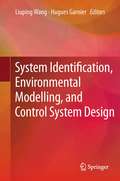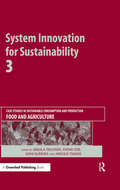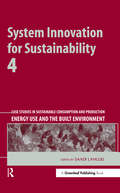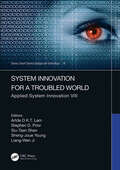- Table View
- List View
System Dependability and Analytics: Approaching System Dependability from Data, System and Analytics Perspectives (Springer Series in Reliability Engineering)
by Long Wang Karthik Pattabiraman Catello Di Martino Arjun Athreya Saurabh BagchiThis book comprises chapters authored by experts who are professors and researchers in internationally recognized universities and research institutions. The book presents the results of research and descriptions of real-world systems, services, and technologies. Reading this book, researchers, professional practitioners, and graduate students will gain a clear vision on the state of the art of the research and real-world practice on system dependability and analytics. The book is published in honor of Professor Ravishankar K. Iyer, the George and Ann Fisher Distinguished Professor in the Department of Electrical and Computer Engineering at the University of Illinois at Urbana-Champaign (UIUC), Urbana, Illinois. Professor Iyer is ACM Fellow, IEEE Fellow, AAAS Fellow, and served as Interim Vice Chancellor of UIUC for research during 2008–2011. The book contains chapters written by many of his former students.
System Design and Control Integration for Advanced Manufacturing
by Han-Xiong Li Xinjiang LuMost existing robust design books address design for static systems, or achieve robust design from experimental data via the Taguchi method. Little work considers model information for robust design particularly for the dynamic system. <P><P>This book covers robust design for both static and dynamic systems using the nominal model information or the hybrid model/data information, and also integrates design with control under a large operating region. This design can handle strong nonlinearity and more uncertainties from model and parameters.
System Development Charges for Water, Wastewater, and Stormwater Facilities
by Arthur C. NelsonThis book presents a comprehensive method by which to determine the proportionate share of the costs and revenues generated by the development of new water, wastewater, and stormwater facilities. It presents a rational, legally defensible approach to assessing charges based on the use of new and existing facilities to support new system development. Written by a consultant who has helped hundreds of communities deal with how to pay for growth, the book is designed for all communities presently engaged in calculating and administering charges for new development, as well as those planning for future growth.
System Dynamics
by Karl A. SeelerThis unique textbook takes the student from the initial steps in modeling a dynamic system through development of the mathematical models needed for feedback control. The generously-illustrated, student-friendly text focuses on fundamental theoretical development rather than the application of commercial software. Practical details of machine design are included to motivate the non-mathematically inclined student.
System Dynamics and Control with Bond Graph Modeling
by Javier KypurosWritten by a professor with extensive teaching experience, System Dynamics and Control with Bond Graph Modeling treats system dynamics from a bond graph perspective. Using an approach that combines bond graph concepts and traditional approaches, the author presents an integrated approach to system dynamics and automatic controls. The textbook guide
System Dynamics for Complex Problems in Pavement Engineering
by Rajib MallickIncreasingly, segments of the civil infrastructure are considered to be parts of larger systems, which requires a systems approach for a fuller and proper understanding of and solutions to problems. Unfortunately, the subject of a system or a systems approach is barely covered in a standard civil and environmental engineering curriculum. Most, if not all, civil engineering problems involve interdependency, and hence segmented approaches of learning one individual topic at a time make it difficult for students to learn, understand, and apply rational concepts for the design, construction, and maintenance of larger infrastructure components. System Dynamics for Complex Problems in Pavement Engineering presents an introduction to a systems approach to help readers evolve and develop their capabilities of learning, communicating, and researching through system dynamics modeling and experimentation.Furthermore, it helps students appreciate the need for systems thinking in modeling, analyzing, and proposing solutions for multidisciplinary problems in pavement engineering.
System Dynamics for Mechanical Engineers
by Tony L. Schmitz Matthew A. DaviesThis textbook is ideal for mechanical engineering students preparing to enter the workforce during a time of rapidly accelerating technology, where they will be challenged to join interdisciplinary teams. It explains system dynamics using analogies familiar to the mechanical engineer while introducing new content in an intuitive fashion. The fundamentals provided in this book prepare the mechanical engineer to adapt to continuous technological advances with topics outside traditional mechanical engineering curricula by preparing them to apply basic principles and established approaches to new problems. This book also: · Reinforces the connection between the subject matter and engineering reality · Includes an instructor pack with the online publication that describes in-class experiments with minimal preparation requirements · Provides content dedicated to the modeling of modern interdisciplinary technological subjects, including opto-mechanical systems, high-speed manufacturing equipment, and measurement systems · Incorporates MATLAB® programming examples throughout the text · Incorporates MATLAB® examples that animate the dynamics of systems
System Dynamics: Modeling, Analysis, Simulation, Design
by Ernest DoebelinAddressing topics from system elements and simple first- and second-order systems to complex lumped- and distributed-parameter models of practical machines and processes, this work details the utility of systems dynamics for the analysis and design of mechanical, fluid, thermal and mixed engineering systems. It emphasizes digital simulation and int
System Dynamics: Modeling, Simulation, and Response
by Osama GadSystem Dynamics: Modeling, Simulation, and Response covers linearity-based modeling techniques before delving into nonlinear systems. It compares the Bond Graph technique against traditional techniques (Newton's law, Kirchhoff's law, the law of the conservation of energy, and the heat transfer law).Presenting transient response analyses of first- and second-order systems subjected to various inputs, the book provides a thorough discussion of computational analyses of transient responses using MATLAB®/Simulink and 20-sim software. It introduces the Lagrangian method and its application in handling mechanical and electrical systems. The book reviews the classical method for solving differential equations and includes Laplace transforms.The book is intended for upper-level undergraduate mechanical and aerospace engineering students taking system dynamics courses.Instructors will be able to utilize a Solutions Manual and Figure Slides for their courses.
System Earth via Geodetic-Geophysical Space Techniques
by Frank M. Flechtner Jens Wickert Markus Rothacher Thomas Gruber M. Mandea Andreas Güntner Tilo SchöneThe Earth's magnetic and gravity field play an important role in global and regional geodynamics. Satellite exploration of these fields has received great attention in recent years. Research satellites such as CHAMP and GRACE as well as the ESA explorer GOCE apply new measurement techniques, thus allowing the recovery of the gravitational and magnetic field with unprecedented accuracy and resolution, spatial as well as temporal. Combined with terrestrial observations and computer models, this data will help develop a more detailed understanding of the Earth as a system. In Germany, many of the processing, modelling and interpreting methodologies for these new observation techniques are developed under the umbrella of the R&D-programme GEOTECHNOLOGIEN, funded by the Federal Ministry of Education and Research (BMBF). The research projects focus on a better understanding of the spatial and temporal variations in the magnetic and gravity field and their relationship to the dynamics of the Earth's interior and global change processes. This volume presents the results of the multidisciplinary studies covered by the programme for the period 2005-2008. It includes the following topics: High-accuracy gravity field models, near-real-time provision and usage of CHAMP and GRACE atmospheric sounding, sea level variations, improved GRACE gravity time series and their validation by ocean bottom pressure measurements, integration of space geodetic techniques as a basis for the Global Geodetic-Geophysical Observing System (GGOS), high-resolution magnetic field models and global magnetisation maps and time-variable gravity and surface mass processes.
System Efficiency by Renewable Electricity: Strategies for Efficient Energy Supply until 2050
by Günther BraunerIn this book, a more detailed analysis is performed on the basis of quarter-hourly time series of the supply of wind energy and photovoltaics. The end use including electromobility is also presented with more detailed time series of the load profiles for summer and winter and thereby for weekdays and weekends in each case. The subsequent analysis clarifies whether the renewable potentials are sufficient, what the optimal generation scenarios and infrastructures of the future could look like, and what the situation is with regard to affordability and environmental compatibility.
System Engineering Analysis, Design, and Development: Concepts, Principles, and Practices (Second Edition)
by Charles S. WassonThis textbook presents a comprehensive, step-by-step guide to System Engineering analysis, design, and development via an integrated set of concepts, principles, practices, and methodologies. The methods presented in this text apply to any type of human system -- small, medium, and large organizational systems and system development projects delivering engineered systems or services across multiple business sectors such as medical, transportation, financial, educational, governmental, aerospace and defense, utilities, political, and charity, among others. Thoroughly illustrated, with end-of-chapter exercises and numerous case studies and examples, Systems Engineering Analysis, Design, and Development, Second Edition is a primary textbook for multi-discipline, engineering, system analysis, and project management undergraduate/graduate level students and a valuable reference for professionals.
System Engineering Applied to Fuenmayor Karst Aquifer (San Julián de Banzo, Huesca) and Collins Glacier (King George Island, Antarctica)
by David ChinarroThis thesis tackles fundamental questions concerning the discharge of a pre-Pyrenean karst aquifer system and an Antarctic glacier system, utilizing a system engineering methodology and data-driven approach. It presents for the first time a simplified and effective linear transfer function for karst aquifers. The author provides detailed wavelet spectrum results, which reveal certain non-linearities in drought periods. In addition, structures based on Hammerstein-Wiener blocks have yielded a nonlinear model that is substantially more efficient than its linear counterparts. Another pioneering finding is the use of wavelet coherence between glacier discharge and air temperature to estimate SEC (Seasonal Effective Core) boundaries. The yearly SEC is essential to obtaining a model based on Hammerstein-Wiener structures, which offers considerably higher efficiency. Moreover, two different types of glacier dynamics have been discovered (over damped and overshoot), depending on the annual cycle and the SEC average temperature.
System Engineering Approach to Planning Anticancer Therapies
by Marek Kimmel Andrzej Świerniak Jaroslaw Smieja Krzysztof Puszynski Krzysztof Psiuk-MaksymowiczThis book focuses on the analysis of cancer dynamics and the mathematically based synthesis of anticancer therapy. It summarizes the current state-of-the-art in this field and clarifies common misconceptions about mathematical modeling in cancer. Additionally, it encourages closer cooperation between engineers, physicians and mathematicians by showing the clear benefits of this without stating unrealistic goals. Development of therapy protocols is realized from an engineering point of view, such as the search for a solution to a specific control-optimization problem. Since in the case of cancer patients, consecutive measurements providing information about the current state of the disease are not available, the control laws are derived for an open loop structure. Different forms of therapy are incorporated into the models, from chemotherapy and antiangiogenic therapy to immunotherapy and gene therapy, but the class of models introduced is broad enough to incorporate other forms of therapy as well. The book begins with an analysis of cell cycle control, moving on to control effects on cell population and structured models and finally the signaling pathways involved in carcinogenesis and their influence on therapy outcome. It also discusses the incorporation of intracellular processes using signaling pathway models, since the successful treatment of cancer based on analysis of intracellular processes, might soon be a reality. It brings together various aspects of modeling anticancer therapies, which until now have been distributed over a wide range of literature. Written for researchers and graduate students interested in the use of mathematical and engineering tools in biomedicine with special emphasis on applications in cancer diagnosis and treatment, this self-contained book can be easily understood with only a minimal basic knowledge of control and system engineering methods as well as the biology of cancer. Its interdisciplinary character and the authors' extensive experience in cooperating with clinicians and biologists make it interesting reading for researchers from control and system engineering looking for applications of their knowledge. Systems and molecular biologists as well as clinicians will also find new inspiration for their research.
System Engineering Management
by Benjamin S. BlanchardTechnology/Engineering/GeneralA top-down, step-by-step, life-cycle approach to systems engineeringIn today's environment, there is an ever-increasing need to develop and produce systems that are robust, reliable, high quality, supportable, cost-effective, and responsive to the needs of the customer or user. Reflecting these worldwide trends, System Engineering Management, Fourth Edition introduces readers to the full range of system engineering concepts, tools, and techniques, emphasizing the application of principles and concepts of system engineering and the way these principles aid in the development, utilization, and support of systems.Viewing systems engineering from both a technical and a management perspective, this fully revised and updated edition extends its coverage to include:*The changing areas of system requirements*Increasing system complexities*Extended system life cycles versus shorter technology cycles*Higher costs and greater international competition*The interrelationship of project management and systems engineering as they work together at the project team levelSupported by numerous, real-life case studies, this new edition of the classic resource demonstrates-step by step-a comprehensive, top-down, life-cycle approach that system engineerscan follow to reduce costs, streamline the design and development process, improve reliability, and win customers.
System Engineering Management (Wiley Series in Systems Engineering and Management)
by Benjamin S. Blanchard John E. BlylerA practical, step-by-step guide to total systems management Systems Engineering Management, Fifth Edition is a practical guide to the tools and methodologies used in the field. Using a "total systems management" approach, this book covers everything from initial establishment to system retirement, including design and development, testing, production, operations, maintenance, and support. This new edition has been fully updated to reflect the latest tools and best practices, and includes rich discussion on computer-based modeling and hardware and software systems integration. New case studies illustrate real-world application on both large- and small-scale systems in a variety of industries, and the companion website provides access to bonus case studies and helpful review checklists. The provided instructor's manual eases classroom integration, and updated end-of-chapter questions help reinforce the material. The challenges faced by system engineers are candidly addressed, with full guidance toward the tools they use daily to reduce costs and increase efficiency. System Engineering Management integrates industrial engineering, project management, and leadership skills into a unique emerging field. This book unifies these different skill sets into a single step-by-step approach that produces a well-rounded systems engineering management framework. Learn the total systems lifecycle with real-world applications Explore cutting edge design methods and technology Integrate software and hardware systems for total SEM Learn the critical IT principles that lead to robust systems Successful systems engineering managers must be capable of leading teams to produce systems that are robust, high-quality, supportable, cost effective, and responsive. Skilled, knowledgeable professionals are in demand across engineering fields, but also in industries as diverse as healthcare and communications. Systems Engineering Management, Fifth Edition provides practical, invaluable guidance for a nuanced field.
System Error: Where Big Tech Went Wrong and How We Can Reboot
by Rob Reich Jeremy M. Weinstein Mehran Sahami"System Error is a triumph: an analysis of the critical challenges facing our digital society that is as accessible as it is sophisticated." — Anne-Marie Slaughter, CEO of New AmericaA forward-thinking manifesto from three Stanford professors—experts who have worked at ground zero of the tech revolution for decades—which reveals how big tech’s obsession with optimization and efficiency has sacrificed fundamental human values and outlines steps we can take to change course, renew our democracy, and save ourselves.In no more than the blink of an eye, a naïve optimism about technology’s liberating potential has given way to a dystopian obsession with biased algorithms, surveillance capitalism, and job-displacing robots. Yet too few of us see any alternative to accepting the onward march of technology. We have simply accepted a technological future designed for us by technologists, the venture capitalists who fund them, and the politicians who give them free rein.It doesn’t need to be this way.System Error exposes the root of our current predicament: how big tech’s relentless focus on optimization is driving a future that reinforces discrimination, erodes privacy, displaces workers, and pollutes the information we get. This optimization mindset substitutes what companies care about for the values that we as a democratic society might choose to prioritize. Well-intentioned optimizers fail to measure all that is meaningful and, when their creative disruptions achieve great scale, they impose their values upon the rest of us.Armed with an understanding of how technologists think and exercise their power, three Stanford professors—a philosopher working at the intersection of tech and ethics, a political scientist who served under Obama, and the director of the undergraduate Computer Science program at Stanford (also an early Google engineer)—reveal how we can hold that power to account.Troubled by the values that permeate the university’s student body and its culture, they worked together to chart a new path forward, creating a popular course to transform how tomorrow’s technologists approach their profession. Now, as the dominance of big tech becomes an explosive societal conundrum, they share their provocative insights and concrete solutions to help everyone understand what is happening, what is at stake, and what we can do to control technology instead of letting it control us.
System Health Management
by Thomas Gormley Charles Mott Seth Kessler Karl Reichard Philip Scandura Jr. Ann Patterson-Hine Stephen B JohnsonSystem Health Management: with Aerospace Applications provides the first complete reference text for System Health Management (SHM), the set of technologies and processes used to improve system dependability. Edited by a team of engineers and consultants with SHM design, development, and research experience from NASA, industry, and academia, each heading up sections in their own areas of expertise and co-coordinating contributions from leading experts, the book collates together in one text the state-of-the-art in SHM research, technology, and applications. It has been written primarily as a reference text for practitioners, for those in related disciplines, and for graduate students in aerospace or systems engineering.There are many technologies involved in SHM and no single person can be an expert in all aspects of the discipline.System Health Management: with Aerospace Applications provides an introduction to the major technologies, issues, and references in these disparate but related SHM areas. Since SHM has evolved most rapidly in aerospace, the various applications described in this book are taken primarily from the aerospace industry. However, the theories, techniques, and technologies discussed are applicable to many engineering disciplines and application areas.Readers will find sections on the basic theories and concepts of SHM, how it is applied in the system life cycle (architecture, design, verification and validation, etc.), the most important methods used (reliability, quality assurance, diagnostics, prognostics, etc.), and how SHM is applied in operations (commercial aircraft, launch operations, logistics, etc.), to subsystems (electrical power, structures, flight controls, etc.) and to system applications (robotic spacecraft, tactical missiles, rotorcraft, etc.).
System Identification
by Karel J. KeesmanSystem Identification shows the student reader how to approach the system identification problem in a systematic fashion. The process is divided into three basic steps: experimental design and data collection; model structure selection and parameter estimation; and model validation, each of which is the subject of one or more parts of the text. Following an introduction on system theory, particularly in relation to model representation and model properties, the book contains four parts covering: * data-based identification - non-parametric methods for use when prior system knowledge is very limited; * time-invariant identification for systems with constant parameters; * time-varying systems identification, primarily with recursive estimation techniques; and * model validation methods. A fifth part, composed of appendices, covers the various aspects of the underlying mathematics needed to begin using the text. The book uses essentially semi-physical or gray-box modeling methods although data-based, transfer-function system descriptions are also introduced. The approach is problem-based rather than rigorously mathematical. The use of finite input-output data is demonstrated for frequency- and time-domain identification in static, dynamic, linear, nonlinear, time-invariant and time-varying systems. Simple examples are used to show readers how to perform and emulate the identification steps involved in various control design methods with more complex illustrations derived from real physical, chemical and biological applications being used to demonstrate the practical applicability of the methods described. End-of-chapter exercises (for which a downloadable instructors' Solutions Manual is available from fill in URL here) will both help students to assimilate what they have learned and make the book suitable for self-tuition by practitioners looking to brush up on modern techniques. Graduate and final-year undergraduate students will find this text to be a practical and realistic course in system identification that can be used for assessing the processes of a variety of engineering disciplines. System Identification will help academic instructors teaching control-related to give their students a good understanding of identification methods that can be used in the real world without the encumbrance of undue mathematical detail.
System Identification Using Regular and Quantized Observations
by Le Yi Wang George G. Yin Qi HeThis brief presents characterizations of identification errors under a probabilistic framework when output sensors are binary, quantized, or regular. By considering both space complexity in terms of signal quantization and time complexity with respect to data window sizes, this study provides a new perspective to understand the fundamental relationship between probabilistic errors and resources, which may represent data sizes in computer usage, computational complexity in algorithms, sample sizes in statistical analysis and channel bandwidths in communications.
System Identification and Adaptive Control
by Yiannis Boutalis Dimitrios Theodoridis Theodore Kottas Manolis A. ChristodoulouPresenting current trends in the development and applications of intelligent systems in engineering, this monograph focuses on recent research results in system identification and control. The recurrent neurofuzzy and the fuzzy cognitive network (FCN) models are presented Both models are suitable for partially-known or unknown complex time-varying systems. Neurofuzzy Adaptive Control contains rigorous proofs of its statements which result in concrete conclusions for the selection of the design parameters of the algorithms presented. The neurofuzzy model combines concepts from fuzzy systems and recurrent high-order neural networks to produce powerful system approximations that are used for adaptive control. The FCN model stems from fuzzy cognitive maps and uses the notion of "concepts" and their causal relationships to capture the behavior of complex systems. The book shows how, with the benefit of proper training algorithms, these models are potent system emulators suitable for use in engineering systems All chapters are supported by illustrative simulation experiments, while separate chapters are devoted to the potential industrial applications of each model including projects in: * contemporary power generation; * process control and * conventional benchmarking problems. Researchers and graduate students working in adaptive estimation and intelligent control will find Neurofuzzy Adaptive Control of interest both for the currency of its models and because it demonstrates their relevance for real systems. The monograph also shows industrial engineers how to test intelligent adaptive control easily using proven theoretical results.
System Identification, Environmental Modelling, and Control System Design
by Hugues Garnier Liuping WangThis book is dedicated to Prof. Peter Young on his 70th birthday. Professor Young has been a pioneer in systems and control, and over the past 45 years he has influenced many developments in this field. This volume comprises a collection of contributions by leading experts in system identification, time-series analysis, environmetric modelling and control system design - modern research in topics that reflect important areas of interest in Professor Young's research career. Recent theoretical developments in and relevant applications of these areas are explored treating the various subjects broadly and in depth. The authoritative and up-to-date research presented here will be of interest to academic researcher in control and disciplines related to environmental research, particularly those to with water systems. The tutorial style in which many of the contributions are composed also makes the book suitable as a source of study material for graduate students in those areas.
System Innovation for Sustainability 3: Case Studies in Sustainable Consumption and Production — Food and Agriculture
by Ursula Tischner Eivind Stø Unni Kjærnes Arnold TukkerThe EU-funded project "Sustainable Consumption Research Exchanges" (SCORE!) consists of around 200 experts in the field of sustainable innovation and sustainable consumption. The SCORE! philosophy is that innovation in SCP policy can be achieved only if experts that understand business development, (sustainable) solution design, consumer behaviour and system innovation policy work together in shaping it. Sustainable technology design can be effective only if business can profitably make the products and consumers are attracted to them. To understand how this might effectively happen, the expertise of systems thinkers must be added to the mix. The publication in 2008 of System Innovation for Sustainability 1 was the first result of a unique positive confrontation between experts from all four communities. It examined what SCP is and what it could be, provided a state-of-the-art review on the governance of change in SCP policy and looked at the strengths and weaknesses of current approaches. System Innovation for Sustainability 3 is the second of three books of case studies covering respectively the three key consumption areas of mobility, food and agriculture, and energy use and housing – responsible for 70% of the life-cycle environmental impacts of Western societies – with the aim of stimulating, fostering or forcing change to SCP theory in practice. The availability of healthy food for all is a basic human need. Yet, primarily due to higher food prices, the overall number of undernourished people in the world increased from 923 million in 2007 to 963 million in 2008 – the vast majority of whom live in developing countries. Experts estimate that close to half of the human impact on the environment is directly or indirectly related to food production and consumption. Food production, distribution, consumption and disposal are important in terms of land and resource use, pollution and emissions, biodiversity and landscape design. Also of key importance are health issues and issues surrounding the satisfaction of citizens' basic needs: more than 200 million adults in the European Union are overweight or even obese due to unhealthy diets and too little exercise. Sustainability issues are now clearly on the agenda for food producers and market actors, politicians and regulators, as well as being increasingly important in the decisions consumers make about food. A large number and variety of efforts to stimulate sustainability have been instigated and numerous studies, research programmes and publications have addressed such issues. Agri-food issues have also been prominent in the evolving definition of what sustainability means. This book focuses largely on providing answers to the question of how food production and consumption systems can stay within the limits of the carrying capacity of our natural environment. But it also considers the challenges of food security and nutrition in the context of sustainability and a growing world population. The book first analyses the state of the art in sustainable agriculture and food production in Europe. Eleven case studies follow, examining issues such as food policy, greening mainstream agricultural systems, organic farming, farmers' markets, sustainable food networks, eco-labelling, consumer behaviour, slow food and fair trade. Finally, a concluding chapter summarises what has been learned by the 60-plus experts active in the SCORE! food project. In brief: bottom-up and top-down processes have to be linked, industrialised nations must reduce their meat consumption, and agriculture should become a multifunctional sustainable system not only producing food but also delivering other services such as energy and material production, CO2 storage and recreation – which would have the added benefit of improving farmers' socioeconomic situations. The System Innovation for Sustainability series is the fruit of the first major international research network on SCP and will set the standard in this field for some years to come. It will be required reading
System Innovation for Sustainability 4: Case Studies in Sustainable Consumption and Production — Energy Use and the Built Environment
by Saadi LahlouThe EU-funded project "Sustainable Consumption Research Exchanges" (SCORE!) consists of around 200 experts in the field of sustainable innovation and sustainable consumption. The SCORE! philosophy is that innovation in SCP policy can be achieved only if experts that understand business development, (sustainable) solution design, consumer behaviour and system innovation policy work together in shaping it. Sustainable technology design can be effective only if business can profitably make the products and consumers are attracted to them. To understand how this might effectively happen, the expertise of systems thinkers must be added to the mix. The publication in 2008 of System Innovation for Sustainability 1 was the first result of a unique positive confrontation between experts from all four communities. It examined what SCP is and what it could be, provided a state-of-the-art review on the governance of change in SCP policy and looked at the strengths and weaknesses of current approaches. System Innovation for Sustainability 4 is the third of three books of case studies covering respectively the three key consumption areas of mobility, food and agriculture, and energy use and the built environment – responsible for 70% of the life-cycle environmental impacts of Western societies – with the aim of stimulating, fostering or forcing change to SCP theory in practice. Energy consumption is obviously a key issue for sustainability, primarily because it depletes non-renewable fossil fuels, produces CO2 and other pollution. As climate change is becoming a key political issue, and as oil prices rise, society has become acutely aware of this issue. Energy is a special case because it is a key input to almost all other consumption and production processes. Housing is, with transport and food, a major consumer of energy, accounting for about one quarter of the environmental impact from the general consumption of products in the European Union, on a par with food and transport. Energy use in houses and buildings is also set to rise as populations – and the buildings they need –continue to increase. In France, for example, energy consumption in houses and offices accounts for 43% of the total national energy consumption, and one-quarter of national greenhouse gas emissions. The UK's 21 million homes consume around 50 million tonnes of oil equivalent (responsible for 27% of UK CO2 emissions); this energy use has increased steadily by about 1.3% per year since 1990. Germany's buildings contribute one-fifth of the country's CO2 emissions. Beyond this, buildings are the environment where we spend most of our lives; they deeply influence many other consumption patterns, and are an important factor for life and comfort. The societal function and nature of buildings as they are currently constructed presents some key difficulties in moving towards sustainable consumption and production. Buildings have a long lifetime; and therefore they are a major target for any structural changes in consumption patterns. Conversely, long lifetimes come with associated strong inertia; therefore the stock of existing buildings is often an obstacle to policies aimed at behavioural change. This book examines, through a case study approach, opportunities to influence energy consumption in housing and buildings and thereby provide options for implementation at a macro, meso and micro level. A growing body of evidence shows that cases demonstrating action towards SCP in energy use in housing can inspire innovation through a range of actors. The cases include examples of steps towards the sustainable use of energy in houses and buildings, from "local experiments", to "innovative communities", to wider regime or non-local scale change in Europe and North America. The System Innovation for Sustainability series is the fruit of the first major international research network on SCP and will set the standard in this field for some years to come. It will be required reading for all involved in the policy debate on sustainable product
System Innovation for a Troubled World: Applied System Innovation VIII. Proceedings of the IEEE 8th International Conference on Applied System Innovation (ICASI 2022), April 21–23, 2022, Sun Moon Lake, Nantou, Taiwan (Smart Science, Design & Technology)
by Stephen D. Prior Siu-Tsen Shen Sheng-Joue Young Liang-Wen Ji Lam, Artde Donald Kin-TakSystem Innovation for a Troubled World: Applied System Innovation VIII contains roughly one tenth of the total of 250 contributions from 8 different countries that were presented at the IEEE 8th International Conference on Applied System Innovation (ICASI 2022, Sun Moon Lake, Nantou, Taiwan, 21-23 April 2022). This book aims to provide an integrated communication platform for researchers from a wide range of topics including: - Information Technology - Communication Science - Applied Mathematics - Computer Science - Advanced Material Science - Engineering System Innovation for a Troubled World: Applied System Innovation VIII aims at science and engineering technologists, academics and professionals from the above mentioned areas.
